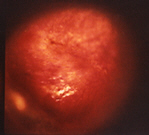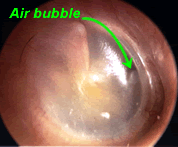The hallmark of acute otitis media (AOM) is the recent onset of a middle ear infection manifesting one or more of the following signs or symptoms: otalgia (tugging or rubbing of the ear in children <2yrs), fever, irritability, anorexia, nausea, vomiting ,diarrhea, rhinitis or more rarely, purulent discharge in the ear canal accompanied by decreased mobility of the tympanic membrane (TM). Otoscopy will reveal an eardrum that is full, bulging and opaque. If the eardrum is intact, pneumatic otoscopy should be used to assess eardrum mobility. Erythema of the eardrum alone is not a definitive finding for AOM. AOM usually follows shortly after the onset of an upper respiratory infection. graphic is an 18 month old male |
 |
